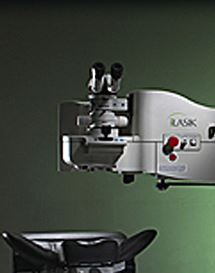Wilmington Laser Eye Surgery – Delaware Eye Surgeons

LASIK (laser-assisted in situ keratomileusis) is an advanced vision correction procedure that involves the use of sophisticated diagnostic technology and laser-guided surgical equipment to reshape the surface of the cornea (the clear outermost part of the eye). The cornea’s new shape alters the angle at which light enters the eye, thereby improving its ability to focus images onto the retina. Laser eye surgery provides effective and permanent treatment for a range of refractive errors, including nearsightedness, farsightedness and astigmatism.
Delaware Eye LASIK eye surgeons produce excellent vision improvements for our patients, who frequently enjoy postoperative vision of 20/20 or better.
The LASIK Procedure
LASIK eye surgery is completed in four steps:
- Analysis of refractive errors
- Creation of the corneal flap
- Reshaping of the cornea
- Repositioning of the corneal flap
Analysis of Refractive Errors
Just like a fingerprint, each individual’s eye is unique. Therefore, LASIK is not a one-size-fits-all type of treatment. The first step of LASIK eye surgery is to identify the patient’s unique refractive errors. Our eye surgeons diagnose refractive errors during a comprehensive dilated eye exam. They assess the refractive status of the eye, the patient’s current method of correction (e.g., eyeglasses, contact lenses), symptoms and visual needs. He will evaluate each eye through retinoscopy, an autorefractor or wavefront analysis.
Wavefront analysis allows our eye surgeon to obtain a three-dimensional map of the eye’s unique characteristics and identify higher-order aberrations, subtle imperfections that contribute to glare, halos and other vision problems. The diagnostic information obtained through wavefront analysis is then used to calibrate the surgical laser (excimer laser) for accurate vision correction. With the use of wavefront analysis, our eye surgeon is able to provide each LASIK patient with a customized laser vision correction treatment, also known as Custom Wavefront LASIK.
Creation of the Corneal Flap
LASIK eye surgery begins with the creation of the corneal flap. A corneal flap is a thin layer of tissue that is lifted from the surface of the eye to expose the underlying cornea. To create the flap, our eye surgeon first administers anesthetic eye drops for maximum patient comfort. Next, a microkeratome (a handheld surgical device) is used to create the corneal flap.
Delaware Eye Surgeons also offers IntraLase, or bladeless LASIK, during which the corneal flap is created with a femtosecond laser specifically designed for this purpose. For more information on bladeless LASIK, please visit our IntraLase page.
Reshaping of the Cornea
Following corneal flap creation, an excimer laser (surgical laser) is used to reshape the cornea. The excimer laser delivers high-energy ultraviolet light to the eye to vaporize microscopic amounts of corneal tissue, thereby correcting visual flaws. Due to the short exposure time of the laser, there is no UV damage to the eye.
This part of LASIK usually lasts less than a minute, during which patients may experience slight pressure without pain.
For more information on wavefront technology and excimer lasers, please visit our LASIKtechnology page.
Repositioning of the Corneal Flap
LASIK eye surgery is completed with the repositioning of the corneal flap, which is carefully placed into its original position to protect the eye during recovery. Stitches are not necessary because the flap naturally bonds to the corneal tissue.
LASIK Results and Recovery
LASIK is an outpatient procedure; however, our Wilmington LASIK eye surgery patients are advised not to operate a vehicle immediately following surgery. It is best to arrange a ride with a family member or a friend. Delaware Eye Surgeons recommends that patients rest for a few hours following LASIK and avoid strenuous activity for 24 to 48 hours. The life-changing results of LASIK are noticeable in the hours immediately following surgery and continue over the next several days. Most patients are able to return to work in one to two days. Medicated eye drops will need to be used for several days postoperatively to reduce any swelling and prevent infection.
LASIK Candidacy
The best LASIK candidates are individuals who are at least 21 years old, have had a stable prescription for two years or more and are in good general health. To qualify for LASIK, patients must have a sufficiently thick cornea for the creation of the corneal flap, which is determined by an eye surgeon in our practice. Individuals who are not good candidates for the procedure may choose from a range of alternative treatment options, including LASEK and Epi-LASIK. In addition, many individuals who do not qualify for LASIK are excellent PRK Wilmington candidates.
Please contact our practice at (302) 993-1300 to schedule your LASIK consultation or use our online appointment request form. We also encourage you to contact us if you would like to learn about any of the other vision correction procedures offered by Delaware Eye Surgeons, such as premium IOLs, cataract surgery in Delaware, glaucoma surgery, corneal transplant surgery, routine eye exams, lens fittings and more.

